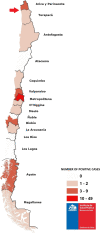Molecular and epidemiological characterization of imported malaria cases in Chile
- PMID: 32792011
- PMCID: PMC7427082
- DOI: 10.1186/s12936-020-03353-y
Molecular and epidemiological characterization of imported malaria cases in Chile
Abstract
Background: Chile is one of the South American countries certified as malaria-free since 1945. However, the recent increase of imported malaria cases and the presence of the vector Anopheles pseudopunctipennis in previously endemic areas in Chile require an active malaria surveillance programme.
Methods: Specimens from 268 suspected malaria cases-all imported-collected between 2015 and 2018 at the Public Health Institute of Chile (ISP), were diagnosed by microscopy and positive cases were included for epidemiological analysis. A photo-induced electron transfer fluorogenic primer real-time PCR (PET-PCR) was used to confirm the presence of malaria parasites in available blood samples. Sanger sequencing of drug resistance molecular markers (pfk13, pfcrt and pfmdr1) and microsatellite (MS) analysis were performed in confirmed Plasmodium falciparum samples and results were related to origin of infection.
Results: Out of the 268 suspected cases, 65 were Plasmodium spp. positive by microscopy. A total of 63% of the malaria patients were male and 37% were female; 43/65 of the patients acquired infections in South American endemic countries. Species confirmation of available blood samples by PET-PCR revealed that 15 samples were positive for P. falciparum, 27 for Plasmodium vivax and 4 were mixed infections. The P. falciparum samples sequenced contained four mutant pfcrt genotypes (CVMNT, CVMET, CVIET and SVMNT) and three mutant pfmdr1 genotypes (Y184F/S1034C/N1042D/D1246Y, Y184F/N1042D/D1246Y and Y184F). MS analysis confirmed that all P. falciparum samples presented different haplotypes according to the suspected country of origin. Four patients with P. vivax infection returned to the health facilities due to relapses.
Conclusion: The timely detection of polymorphisms associated with drug resistance will contribute to understanding if current drug policies in the country are appropriate for treatment of imported malaria cases and provide information about the most frequent resistant genotypes entering Chile.
Keywords: Chile; Malaria; Microsatellites; PCR; Surveillance; pfcrt; pfmdr1.
Conflict of interest statement
The authors declare that they have no competing interests.
Figures



Similar articles
-
Transmission dynamics of co-endemic Plasmodium vivax and P. falciparum in Ethiopia and prevalence of antimalarial resistant genotypes.PLoS Negl Trop Dis. 2017 Jul 26;11(7):e0005806. doi: 10.1371/journal.pntd.0005806. eCollection 2017 Jul. PLoS Negl Trop Dis. 2017. PMID: 28746333 Free PMC article.
-
Polymorphisms of pfcrt, pfmdr1, and K13-propeller genes in imported falciparum malaria isolates from Africa in Guizhou province, China.BMC Infect Dis. 2020 Jul 16;20(1):513. doi: 10.1186/s12879-020-05228-8. BMC Infect Dis. 2020. PMID: 32677899 Free PMC article.
-
Prevalence of Plasmodium falciparum Pfcrt and Pfmdr1 alleles in settings with different levels of Plasmodium vivax co-endemicity in Ethiopia.Int J Parasitol Drugs Drug Resist. 2019 Dec;11:8-12. doi: 10.1016/j.ijpddr.2019.09.002. Epub 2019 Sep 9. Int J Parasitol Drugs Drug Resist. 2019. PMID: 31539706 Free PMC article.
-
Plasmodium vivax in the Era of the Shrinking P. falciparum Map.Trends Parasitol. 2020 Jun;36(6):560-570. doi: 10.1016/j.pt.2020.03.009. Epub 2020 Apr 22. Trends Parasitol. 2020. PMID: 32407682 Free PMC article. Review.
-
Should we care about Plasmodium vivax and HIV co-infection? A systematic review and a cases series from the Brazilian Amazon.Malar J. 2021 Jan 6;20(1):13. doi: 10.1186/s12936-020-03518-9. Malar J. 2021. PMID: 33407474 Free PMC article.
Cited by
-
Assessment of Plasmodium falciparum anti-malarial drug resistance markers in pfcrt and pfmdr1 genes in isolates from Honduras and Nicaragua, 2018-2021.Malar J. 2021 Dec 14;20(1):465. doi: 10.1186/s12936-021-03977-8. Malar J. 2021. PMID: 34906144 Free PMC article.
-
Diagnostic Methods for Non-Falciparum Malaria.Front Cell Infect Microbiol. 2021 Jun 17;11:681063. doi: 10.3389/fcimb.2021.681063. eCollection 2021. Front Cell Infect Microbiol. 2021. PMID: 34222049 Free PMC article. Review.
-
Prevalence, Parasite Density and Determinants of Falciparum Malaria Among Febrile Children in Some Peri-Urban Communities in Southwestern Nigeria: A Cross-Sectional Study.Infect Drug Resist. 2021 Aug 18;14:3219-3232. doi: 10.2147/IDR.S312519. eCollection 2021. Infect Drug Resist. 2021. PMID: 34434052 Free PMC article.
-
PET-PCR reveals low parasitaemia and submicroscopic malarial infections in Honduran Moskitia.Malar J. 2023 Mar 28;22(1):110. doi: 10.1186/s12936-023-04538-x. Malar J. 2023. PMID: 36978056 Free PMC article.
-
A PCR-RFLP Technique to Assess the Geographic Origin of Plasmodium falciparum Strains in Central America.Trop Med Infect Dis. 2022 Jul 26;7(8):149. doi: 10.3390/tropicalmed7080149. Trop Med Infect Dis. 2022. PMID: 35893657 Free PMC article.
References
-
- WHO. Malaria. Geneva: World Health Organization. http://www.who.int/ith/diseases/malaria/en/. Accessed 10 Jan 2019.
-
- WHO. World malaria report 2018. Geneva: World Health Organization. https://apps.who.int/iris/bitstream/handle/10665/275867/9789241565653-en.... Accessed 5 Mar 2019.
-
- OPS/OMS. Situación de la Malaria en la Región de las Américas, 2000–2016. Organización Panamericana de la Salud, Organización Mundial de la Salud. https://www.paho.org/hq/index.php?option=com_docman&view=download&catego.... Accessed 10 Jan 2019.
-
- Grillet ME, Villegas L, Oletta JF, Tami A, Conn JE. Malaria in Venezuela requires response. Science. 2018;359:528. - PubMed
MeSH terms
LinkOut - more resources
Full Text Sources
Miscellaneous

